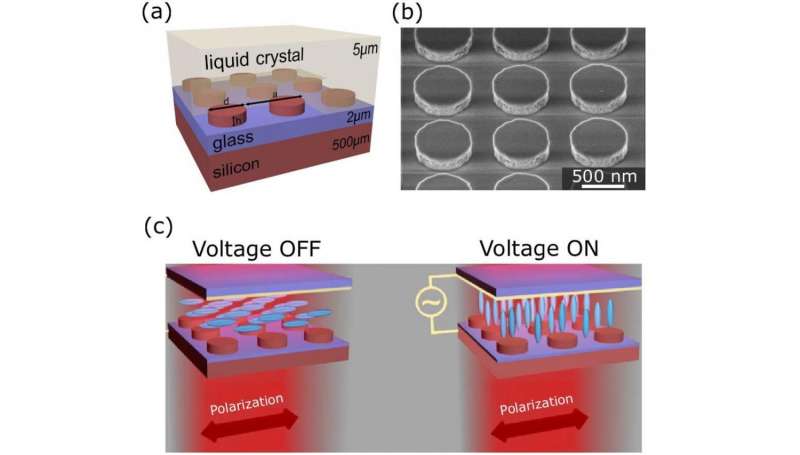March 2, 2017 feature
Electrically tunable metasurfaces pave the way toward dynamic holograms

(Phys.org)—Dynamic holograms allow three-dimensional images to change over time like a movie, but so far these holograms are still being developed. The development of dynamic holograms may now get a boost from recent research on optical metasurfaces, a type of photonic surface with tunable optical properties.
In a new study published in Applied Physics Letters, a team of scientists at The Australian National University in Canberra, Australia; Friedrich Schiller University Jena in Jena, Germany; and Sandia National Laboratories in Albuquerque, New Mexico, US, has demonstrated a new way to tune optical metasurfaces.
A metasurface is a thin sheet consisting of a periodic array of nanoscale elements. The exact dimensions of these elements is critical, since they are specifically designed to manipulate certain wavelengths of light in particular ways that enhance their electric and magnetic properties.
Here, the scientists demonstrated how to manipulate a metasurface by applying an electrical voltage. By switching the control voltage "on" and "off," the researchers could change the optical transmission of the metasurface. For instance, they could tune the transmission from opaque to the transparent regime for certain wavelengths, achieving a transmittance change of up to 75%. The voltage switch could also change the phase of certain wavelengths by up to 180°.
"We demonstrate a new technology platform that enables tuning of optical metasurfaces with large contrast by simple application of a voltage," Dragomir Neshev, a physics professor at The Australian National University, told Phys.org. "From an application perspective, it adds to the significance that our tuning concept is based on a similar technology as used in commercial liquid crystal displays, which would largely facilitate the translation of our concept to real-world applications of tunable metasurfaces."
The way this tuning works is that the voltage physically changes the elements of the metasurface. The metasurface is made of a square lattice of 600-nm-diameter silicon nanodisks embedded into a liquid crystal. When the voltage is "off," the elongated molecules of the liquid crystal lie parallel to the metasurface. Turning the voltage "on" reorients the liquid crystal molecules so that they stand up perpendicular to the metasurface. Light waves interact with the metasurface differently depending on the orientation of the liquid crystal.
While other methods of metasurface tuning have been suggested, these have various drawbacks, such as that they work slowly and require assistance that makes them impractical for immediate applications. Since the new electrically tunable metasurface works quickly and simply, the researchers expect that the method could have a wide variety of applications, including dynamic holograms, tunable imaging, and active beam steering.
"Regarding a long-term vision or inspiration for the development of dynamic holographic devices, we can watch almost any science fiction movie," Neshev said. "Most of them feature holographic man-machine interaction devices for visualization and communication purposes, where the hologram moves and changes in time based on user input.
"While we are still far from this goal, a realistic medium-term application of our metasurfaces are tunable lenses for laser microscopy applications and beam shapers with enhanced functionalities, such as polarization selective response. Active beam steering or beam shaping could be applied in communications or as components in optical laboratory setups."
More information: Andrei Komar et al. "Electrically tunable all-dielectric optical metasurfaces based on liquid crystals." Applied Physics Letters. DOI: 10.1063/1.4976504
ABSTRACT
We demonstrate electrical tuning of the spectral response of a Mie-resonant dielectric metasurface consisting of silicon nanodisks embedded into liquid crystals. We use the reorientation of nematic liquid crystals in a moderate applied electric field to alter the anisotropic permittivity tensor around the metasurface. By switching a control voltage "on" and "off," we induce a large spectral shift of the metasurface resonances, resulting in an absolute transmission modulation of up to 75%. Our experimental demonstration of voltage control of dielectric metasurfaces paves the way for new types of electrically tunable metadevices, including dynamic displays and holograms.
Journal information: Applied Physics Letters
© 2017 Phys.org




















